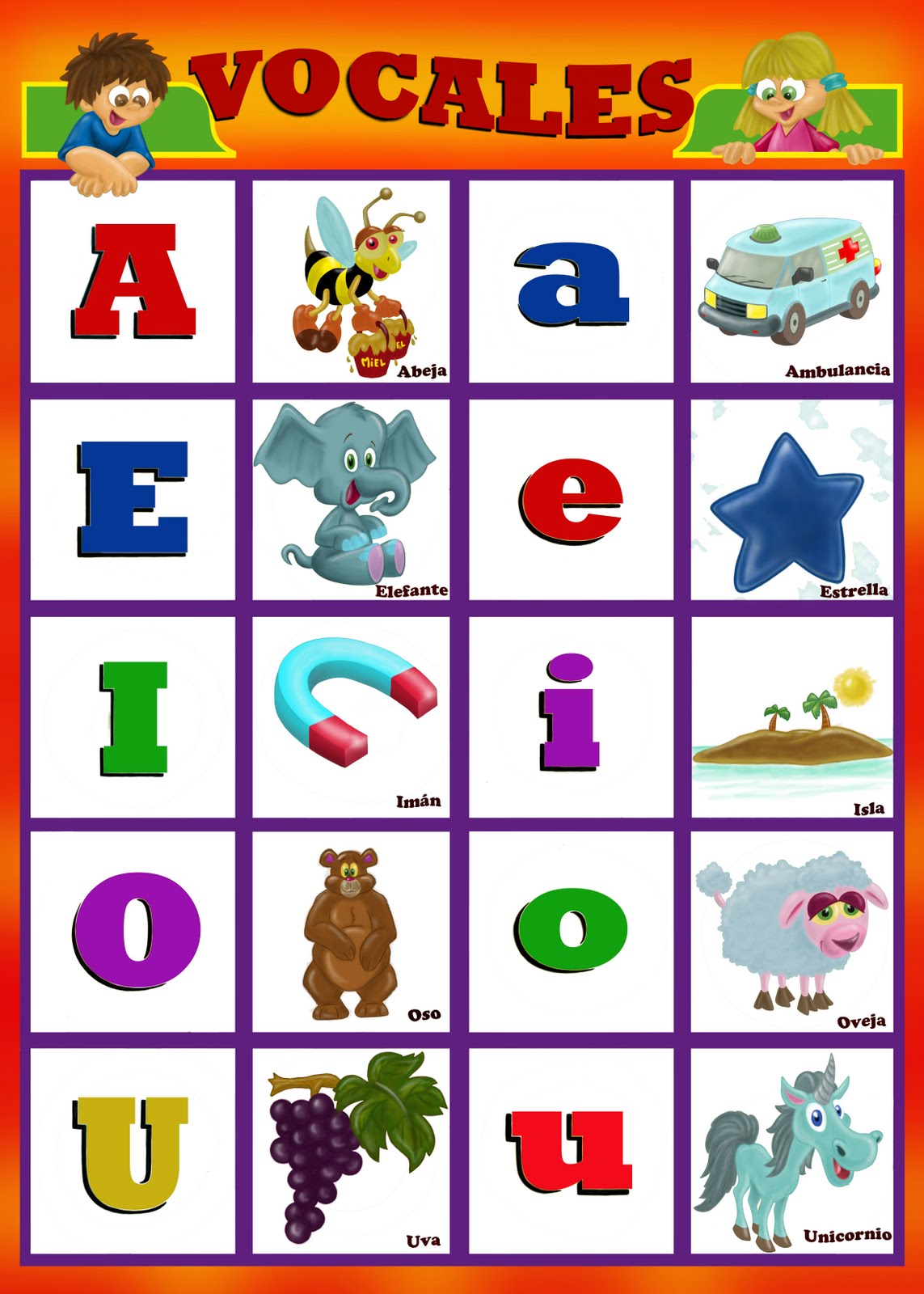What are the building blocks of Spanish pronunciation? Las vocales, or vowels in English, are the foundation of spoken Spanish.
Las vocales are the sounds /a/, /e/, /i/, /o/, and /u/. They can be pronounced in a variety of ways, depending on the surrounding consonants and the stress patterns of the word. For example, the /a/ sound in "casa" (house) is pronounced differently than the /a/ sound in "mano" (hand).
Las vocales are essential for communication in Spanish. They allow us to distinguish between words that sound similar, such as "peso" (weight) and "piso" (floor). They also help us to convey emotions and intonation. For example, the /i/ sound in "s" (yes) is pronounced with a higher pitch than the /i/ sound in "no" (no).
Las vocales are a fascinating and important part of the Spanish language. By understanding how they work, you can improve your pronunciation and communication skills.
Las vocales
Las vocales, or vowels in English, are the foundation of spoken Spanish. They are essential for communication, allowing us to distinguish between words that sound similar and to convey emotions and intonation.
- Pronunciation: Las vocales can be pronounced in a variety of ways, depending on the surrounding consonants and the stress patterns of the word.
- Communication: Las vocales are essential for communication in Spanish, allowing us to distinguish between words that sound similar.
- Emotion: Las vocales can also help us to convey emotions and intonation.
- History: The Spanish vowel system has evolved over time, from the Latin vowel system to the modern Spanish vowel system.
- Dialects: Las vocales can vary in pronunciation depending on the dialect of Spanish that is being spoken.
These are just a few of the key aspects of las vocales. By understanding how they work, you can improve your pronunciation and communication skills in Spanish.
Pronunciation
The pronunciation of las vocales is influenced by a number of factors, including the surrounding consonants and the stress patterns of the word. For example, the /a/ sound in "casa" (house) is pronounced differently than the /a/ sound in "mano" (hand). This is because the /s/ sound in "casa" changes the way that the /a/ sound is pronounced.
- Position: The position of a vowel within a word can affect its pronunciation. For example, the /a/ sound in "gato" (cat) is pronounced differently than the /a/ sound in "agua" (water).
- Stress: The stress patterns of a word can also affect the pronunciation of las vocales. For example, the /a/ sound in "casa" (house) is pronounced differently than the /a/ sound in "casar" (to marry).
- Consonants: The consonants that surround a vowel can also affect its pronunciation. For example, the /a/ sound in "cama" (bed) is pronounced differently than the /a/ sound in "mano" (hand).
- Dialects: The pronunciation of las vocales can also vary depending on the dialect of Spanish that is being spoken.
Understanding how las vocales are pronounced is essential for speaking Spanish correctly. By paying attention to the factors that influence the pronunciation of las vocales, you can improve your pronunciation and communication skills.
Communication
Las vocales are essential for communication in Spanish because they allow us to distinguish between words that sound similar. For example, the words "peso" (weight) and "piso" (floor) are pronounced very similarly, but the /e/ sound in "peso" and the /i/ sound in "piso" allow us to tell them apart.
This is especially important in Spanish, where there are many words that are spelled very similarly but have different meanings. For example, the words "baca" (roof rack) and "vaca" (cow) are spelled very similarly, but the /a/ sound in "baca" and the /a/ sound in "vaca" allow us to tell them apart.
Understanding the importance of las vocales for communication in Spanish can help us to improve our pronunciation and communication skills. By paying attention to the different vowel sounds, we can avoid making mistakes that could lead to misunderstandings.
Emotion
Las vocales are essential for conveying emotions and intonation in Spanish. This is because the different vowel sounds can be used to create different emotional effects. For example, the /i/ sound is often used to express happiness or excitement, while the /u/ sound is often used to express sadness or anger.
The intonation of a word can also be changed by changing the vowel sounds. For example, a word that is spoken with a rising intonation will sound more questioning, while a word that is spoken with a falling intonation will sound more declarative.
Understanding how to use las vocales to convey emotions and intonation is essential for effective communication in Spanish. By paying attention to the different vowel sounds and intonation patterns, you can improve your ability to express yourself clearly and effectively.
History
Las vocales, or vowels in English, are the foundation of spoken Spanish. They are essential for communication, allowing us to distinguish between words that sound similar and to convey emotions and intonation. The Spanish vowel system has evolved over time, from the Latin vowel system to the modern Spanish vowel system.
- Latin vowel system: The Latin vowel system had 10 vowels: /a/, /e/, /i/, /o/, /u/, //, //, //, /y/, and //. These vowels were used to represent the sounds of spoken Latin.
- Modern Spanish vowel system: The modern Spanish vowel system has 5 vowels: /a/, /e/, /i/, /o/, and /u/. These vowels are used to represent the sounds of spoken Spanish.
The evolution of the Spanish vowel system from the Latin vowel system to the modern Spanish vowel system is a complex process that has been influenced by a number of factors, including the influence of other languages, such as Arabic and French, and the changes in the pronunciation of Spanish over time.
Dialects
The pronunciation of las vocales can vary depending on the dialect of Spanish that is being spoken. This is because dialects are regional variations of a language that have their own unique pronunciation patterns. For example, in some dialects of Spanish, the /a/ sound in "casa" (house) is pronounced as a more open sound, while in other dialects it is pronounced as a more closed sound.
This variation in pronunciation can be due to a number of factors, including the historical development of the dialect, the influence of other languages, and the geographical isolation of the dialect. For example, the Spanish spoken in the Canary Islands has been influenced by the Portuguese language, and as a result, the pronunciation of las vocales in the Canary Islands is different from the pronunciation of las vocales in other parts of Spain.
Understanding the variation in the pronunciation of las vocales is important for effective communication. When speaking to someone from a different dialect, it is important to be aware of the different pronunciation patterns that they may use. By doing so, you can avoid misunderstandings and communicate more effectively.
Las vocales
Las vocales, or vowels in English, are the foundation of spoken Spanish. They are essential for communication, allowing us to distinguish between words that sound similar and to convey emotions and intonation. Here are some frequently asked questions about las vocales:
Question 1: How many vowels are there in Spanish?
There are 5 vowels in Spanish: a, e, i, o, and u.
Question 2: How are vowels pronounced in Spanish?
The pronunciation of vowels in Spanish can vary depending on the surrounding consonants and the stress patterns of the word. However, there are some general rules that can help you pronounce vowels correctly.
Question 3: What is the difference between open and closed vowels?
Open vowels are pronounced with the mouth open, while closed vowels are pronounced with the mouth more closed. For example, the /a/ sound in "casa" (house) is an open vowel, while the /i/ sound in "vino" (wine) is a closed vowel.
Question 4: How can I improve my pronunciation of vowels in Spanish?
The best way to improve your pronunciation of vowels in Spanish is to practice speaking the language. You can also listen to native Spanish speakers and try to imitate their pronunciation.
Question 5: Are there any dialects of Spanish that have different vowel pronunciations?
Yes, there are some dialects of Spanish that have different vowel pronunciations. For example, in some dialects of Spanish, the /a/ sound in "casa" (house) is pronounced as a more open sound, while in other dialects it is pronounced as a more closed sound.
Question 6: How can I learn more about las vocales?
There are many resources available to help you learn more about las vocales. You can find books, websites, and videos that can teach you about the pronunciation, history, and use of vowels in Spanish.
These are just a few of the frequently asked questions about las vocales. By understanding how vowels work in Spanish, you can improve your pronunciation and communication skills.
Next Article Section:
Las vocales
Las vocales, or vowels in English, are the foundation of spoken Spanish. They are essential for communication, allowing us to distinguish between words that sound similar and to convey emotions and intonation. We have explored the pronunciation, history, and dialects of las vocales, and we have seen how they are used in everyday speech.
Understanding las vocales is essential for effective communication in Spanish. By paying attention to the different vowel sounds and intonation patterns, you can improve your pronunciation and communication skills. So next time you speak Spanish, take some time to think about the vowels you are using. By doing so, you will be able to communicate more clearly and effectively.
Hilarious Comedy At GoAnimate Comedy World
Propane For Your Home: Affordable And Efficient Heating Solution
The Ultimate Guide To The Lotus Position: What It Is And How To Do It

DIDÁCTICA INFANTIL JUEGA Y APRENDE LAS VOCALES

LAS VOCALES MIS AMIGAS LAS VOCALES

VÍDEO CUENTO PARA APRENDER LAS VOCALES «Las Vocales con Animales» A